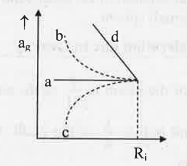A (non-rotating) star collapses onto itself from an initial radius Ri, its mass remaining unchanged. Which curve in the figure best gives the gravitational acceleration ag, on the surface of the star as a function of radius of star during collapse?
 Solution in Marathi
Solution in Marathi
a
b
c
d
Step by step video & image solution for A (non-rotating) star collapses onto itself from an initial radius R_i, its mass remaining unchanged. Which curve in the figure best gives the gravitational acceleration a_g, on the surface of the star as a function of radius of star during collapse? by Physics experts to help you in doubts & scoring excellent marks in Class 11 exams.
Updated on:21/07/2023Topper's Solved these Questions
Similar Questions
A body while sliding went straight down an incline of 45∘ to the horizontal and was subjected to a coefficient of kinetic friction of 0.20. Starting from rest, hwo long did it take him to reach a speed of 50km/hr? (Ignore air resistance and take h=10m/s2)
View SolutionWhen a bus suddenly takes a turn, the passengers are thrown outwards because of
View SolutionA star of mass equal to two solar masses and radius 10^(6) km rotates about its axis with an angular speed of 10^(-6)rad s^(-1) . What is the angular speed of the star, when it collapses (due to inward gravitational forces) to a radius of 10^(4) km ?
View SolutionWhy spin angular velocity of a star is greatly enhanced when it collapses under gravitational pull and becomes a neutron star ?
View SolutionA(nonrotating) star collaps onto from an initial radius Ri with its mass remaining unchanged. Which curve in figure best gives the gravitational acceleration ag on the surface of the star as a function of the radius of the star during the collapse?

View SolutionIf a spherically symmetric star of radius R collapsed under its own weight, neglecting any forces other than gravitational ones, what is the time required for collapse?
View SolutionA pulsar is a rapidly rotating neutron star, the result of the gravitational collapse of an ordinary star that has used up its fuel supply. A certain pulsar has a rotational period of T=0.033 sec and radius R=1//38 km . The tangential speed of a point on the equator is "___________" (km//s)
View SolutionCertain neutron stars are believed to be rotating at about 1rev//sec . If such a star has a radius of 20 km , the acceleration of an object on the equator of the star will be
View SolutionThe moment of inertia of a collapsing star changes to one-third of its initial value. The ratio of the new rotational kinetic energy to the initial rotational kinetic energy is ___
View SolutionA star of mass twice the solar mass and radius 106 km rotates about its axis with an angular speed of 10−6rads−1. What is the angular speed of the star when it collapses (due to inward gravitational) force) to a radius of 104km?
View SolutionA star of mass twice the solar mass and radius 10^(6) km rotates about its axis with an angular speed of 10^(-6)"rad"s^(-1) . What is the angular speed of the star when it collapses (due to inward gravitational) force) to a radius of 10^(4)km ?
View Solutionकथन : जब एक तारे का सिकुड़ते हुए पतन होता है तो इसका कोणीय वेग बढ़ता है।
कारण : तारे का द्रव्यमान कम होता जाता है।
View Solution(A) : The spin angular velocity of a star is greatly enhanced when it collapse under gravitiational pull and become a neuton star.
(R ) : According to law of conservation of angular momentum there is increase in angular velocity of collapsing star.
View SolutionWhat stops the collapse of a white dwarf and a neutron star ?
View SolutionAn impermeable star shrinks itself from the initial radius R in such a way that its mass remains fixed. Which of the given curves represents the gravitational acceleration on the star's surface as a function of the radius of the star?
View SolutionCertain neutron stars are believed to be rotating at about 1rev//sec . If such a star has a radius of 20 km , the acceleration of an object on the equator of the star will be
View Solution
